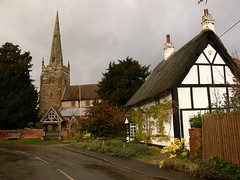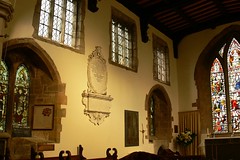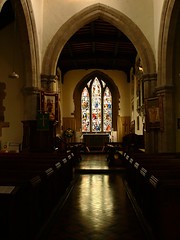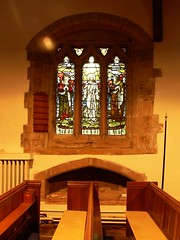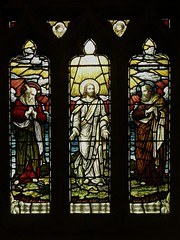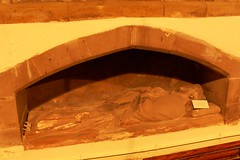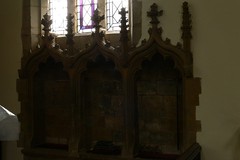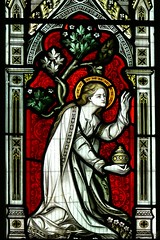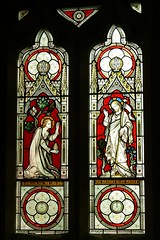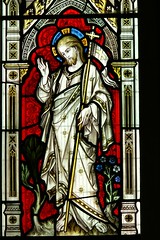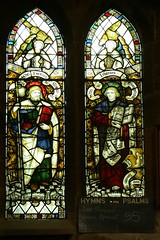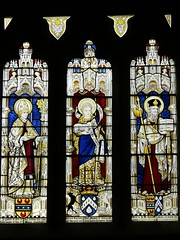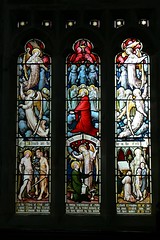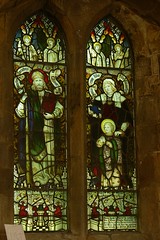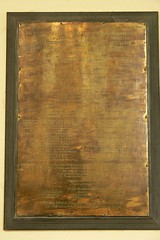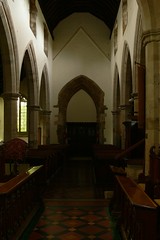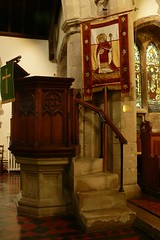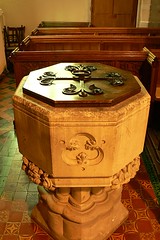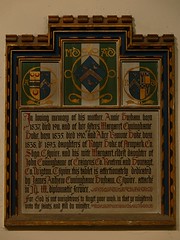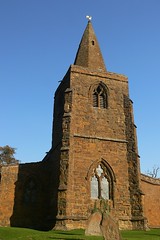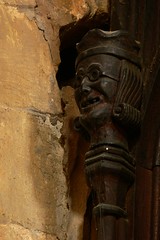
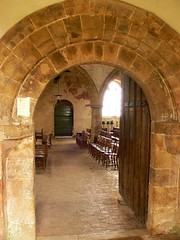
The Domesday book records that there was a small Saxon church occupying this site where the current nave is. At that time the land was owned by the saxon Lord Harold of Sudeley who mainly owned land in Gloucestershire.
The present church is built of Hornton stone and dates from the early C12 through to C13, the oldest parts being the Norman doorways in the South and North. In the C12 the Sudeley family founded the Augustinian monastery at Arbury donating some of the land at Burton Dassett to it.


Cut into the hillside the chancel slopes upwards ten feet above the nave. The altar which is almost level with the capitals of the arcade arches.

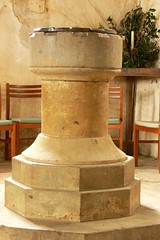
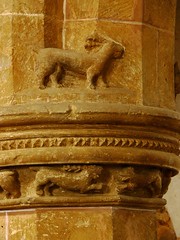
For many years the plain cylindrical bowl of the font was abandoned in the churchyard. Now replaced inside the church it is thought to be C15 but its date is uncertain. The base and stem are modern.

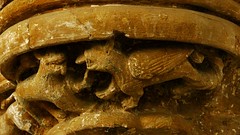
The carved capitals of the north arcade pillars are no later than the late C13 and include hounds, rabbits, dragons, and other mythical creatures.
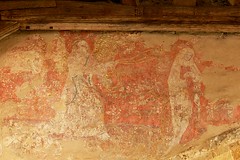
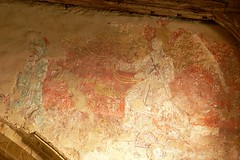
Much of the original medieval plaster of ‘daub’ mixed with lime, and chopped straw and cowhair survives. It was painted with bright murals which after 100s of years of being whitewashed over, and covered with ornamented texts they are starting to reappear. The medieval wall painting above the chancel arch depicts two censing angels the Virgin and St. John which are C14. These are painted over an earlier C13 "Doom" (Last Judgment).
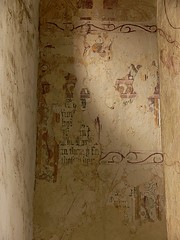
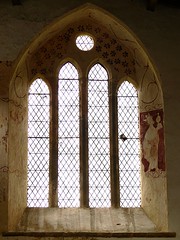

The window in the north transept has images of the Three Magi.
Comments Off on Burton Dassett – All Saints
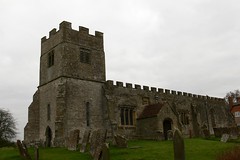
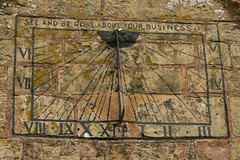
The parish church of St. Giles, Chesterton, is mostly of an early C14 Decorative design, with some remnants of an earlier C13 church. The church itself is in an isolated field some distance from the village, but near to the old Peytos mansion that was pulled down in 1802. Its isolation makes the inscription on the sundial strange, as there were hardly ever anyone around to loiter.
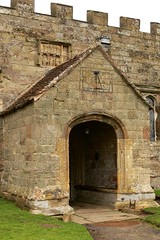
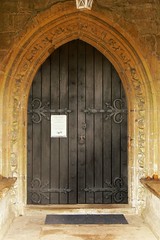
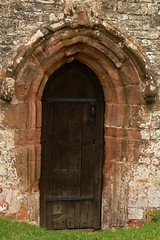
The porch is c1400, leading to an early C13 south doorway carved with ballflowers. To the east is an early C14 priest doorway.
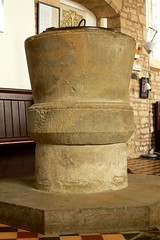
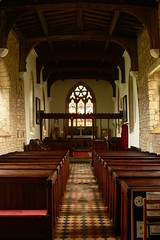
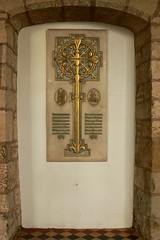
Inside is the door is a C13 font with a tapering round bowl. The church itself is long and narrow consisting of nave and chancel, without any division between the two. The blocked north door is probably the oldest part of the church being a remnant of the earlier C12 building. It used to be the entrance used by the Peyto family and now incorporates a memorial to the 1914-1918 war.
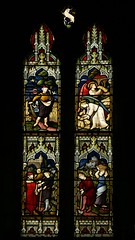
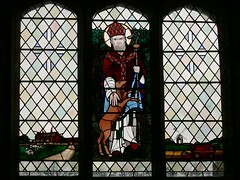
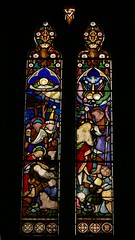
The North and South chancel window are c1330 inset with Victorian stained glass, the north window incorporates some fragments of C15 glass, the south window is from the Hardman Studios Birmingham (1890). The large window in the south wall of the nave is C15 with modern stained glass.
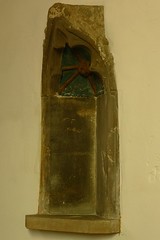
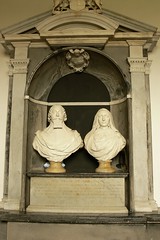
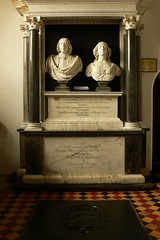
The chancel also contains a modern piscina inserted into C14 image niche with a ribbed vaulted soffit and crocket enrichment. At the west end of the church are Baroque memorial monuments to the Peyto family. The first memorial is to William Peyto, 1619, and his wife Eleanor, was commissioned from by the Sculptor and Architect Nicholas Stone at a cost of £150. The second memorial is to Edward Peyto 1643 and Elizabeth his wife. The busts are set on a pedestal flanked by shafts of dark marble with white Corinthian capitals. This monument was made by John Stone the son of Nicholas Stone, and designer of the old mansion.
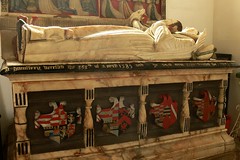
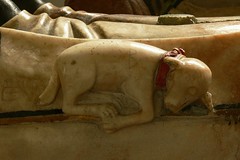
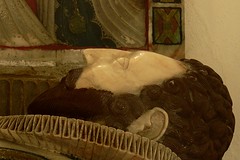
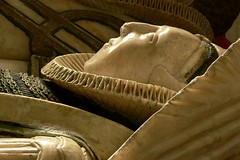
On the south wall is a late C16 alabaster tomb of Humfrey Peyto (d 30 March 1585), and Anne his wife. The date of Anne’s death (1604) is not recorded on the tomb. The tomb was made by craftsmen in Burton-on-Trent, which by the end of C16 had become the centre for work of this type having supplanted those of Nottingham.
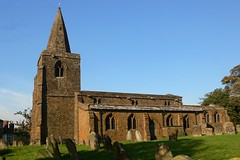
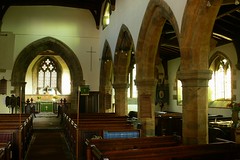
14th century parish church of St. Peter and St. Clare, Fenny Compton. Extensive remodeling of the aisle and arcade occurred late in the century when the tower was added. The clerestory was added in the 16th century, however there is no trace of the original 14th century flat roof. All the windows are modern stonework, except for those in the north clerestory which are 16th century. The roof was restored in 1879.
The communion rails have turned balusters of the 17th century.
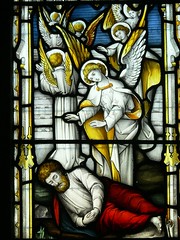
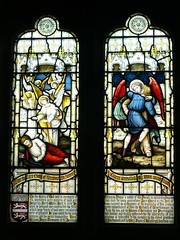
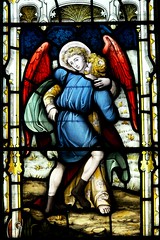
This Victorian memorial window in the north wall is dedicated to a Thomas Payne an engineer who built an embankment across the Glaslyn estuary at Porthmadog. Porthmadoc itself is built on the land reclaimed as a result of the embankment.
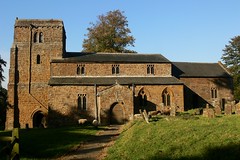
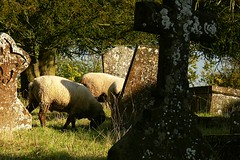
Parts of St. Peter’s church are early 12th century, with the tower being added in the later part of the century, the church was valued at £10 in 1291.
By the late 15th century the medieval village was deserted. The Public Records Office has a document from 1498 where a jury states that 60 occupants of the village were driven out:
weeping to wander in idleness…[and] perished of hunger.
A Social History of England, 1200-1500 (p127)
The modern village dates from the mid Victorian period.
The village and estate was owned by the Spencer family. Wormleighton was the former manor house for the Spencer’s. They were owners in 1469 and bought the lordship of Wormleighton from the Copes in 1507. Their money came from sheep farming, and by the 1600s the estate had some 20,000 head.
From the early 13th century churches installed a rood (choir, or chancel) screen to separate the congregation from the clergy. This followed the following the exposition of the doctrine of transubstantiation at the fourth Lateran Council of 1215, after which the clergy were obliged to protect the sacrament from irreverant access or abuse. Prior to this period the chancel had curtains which were drawn across the altar at specific points in the Mass. However, the nave of the church was often used for secular activities and some permanent division was felt necessary.
This particular screen is from the 15th century ornately carved and hidden high up on the left hand corner is a carving of a man wearing spectacles.
The plaque above the door is a memorial to Diana Spencer.
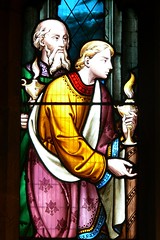

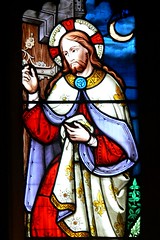
The Victorian glass below is set into a 13th century lancet window at the western wall is dedicated to Richard William Rann. The stained glass window above is set into the 14th century south wall. However, the glass itself is Victorian and was dedicated to Rev. Robert Maynard (1814-1869), who was parish priest at Wormleighton for 27 years.


The floor of the nave contains medieval tiles, one of which has the impression of cat paws.
Church website.
































